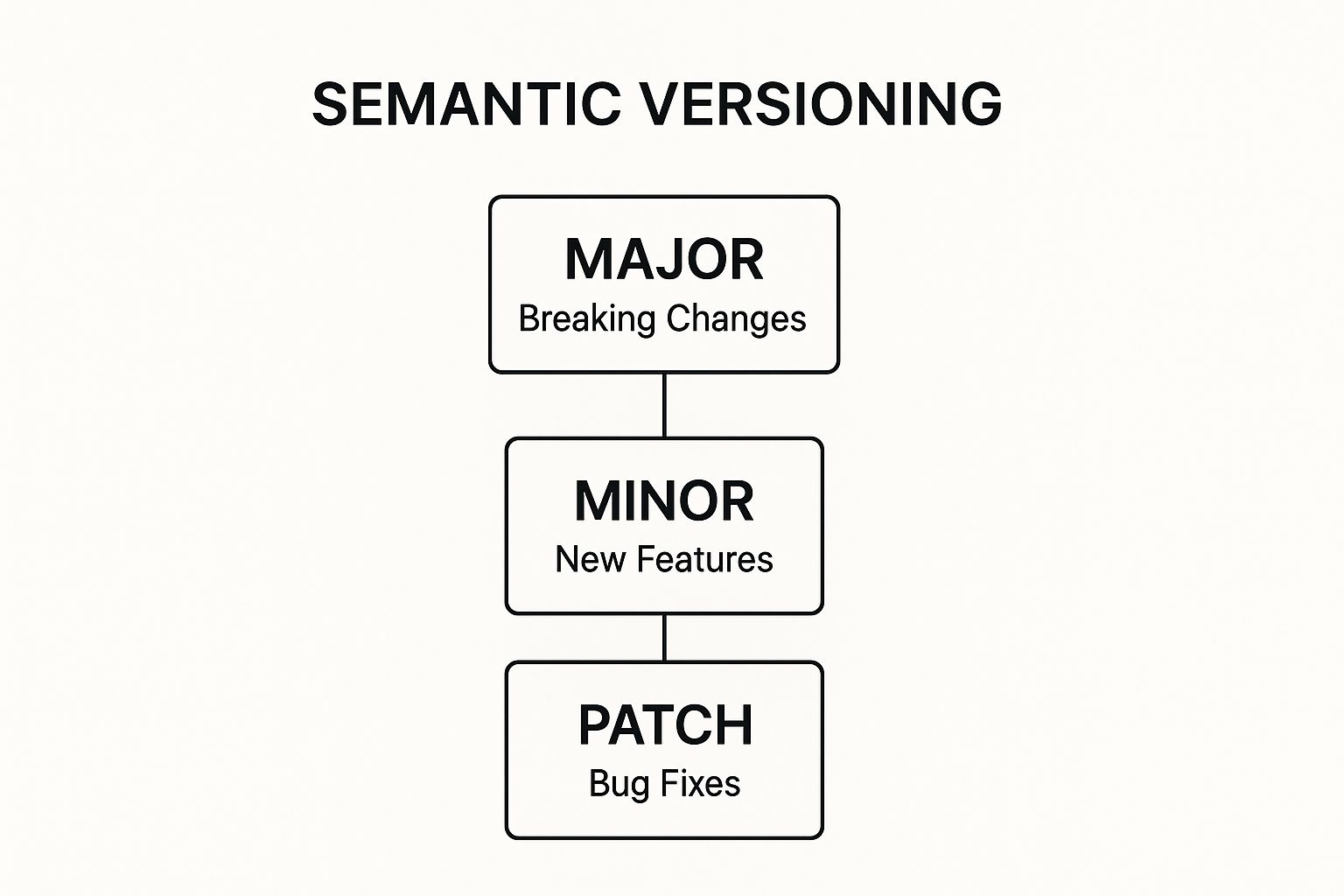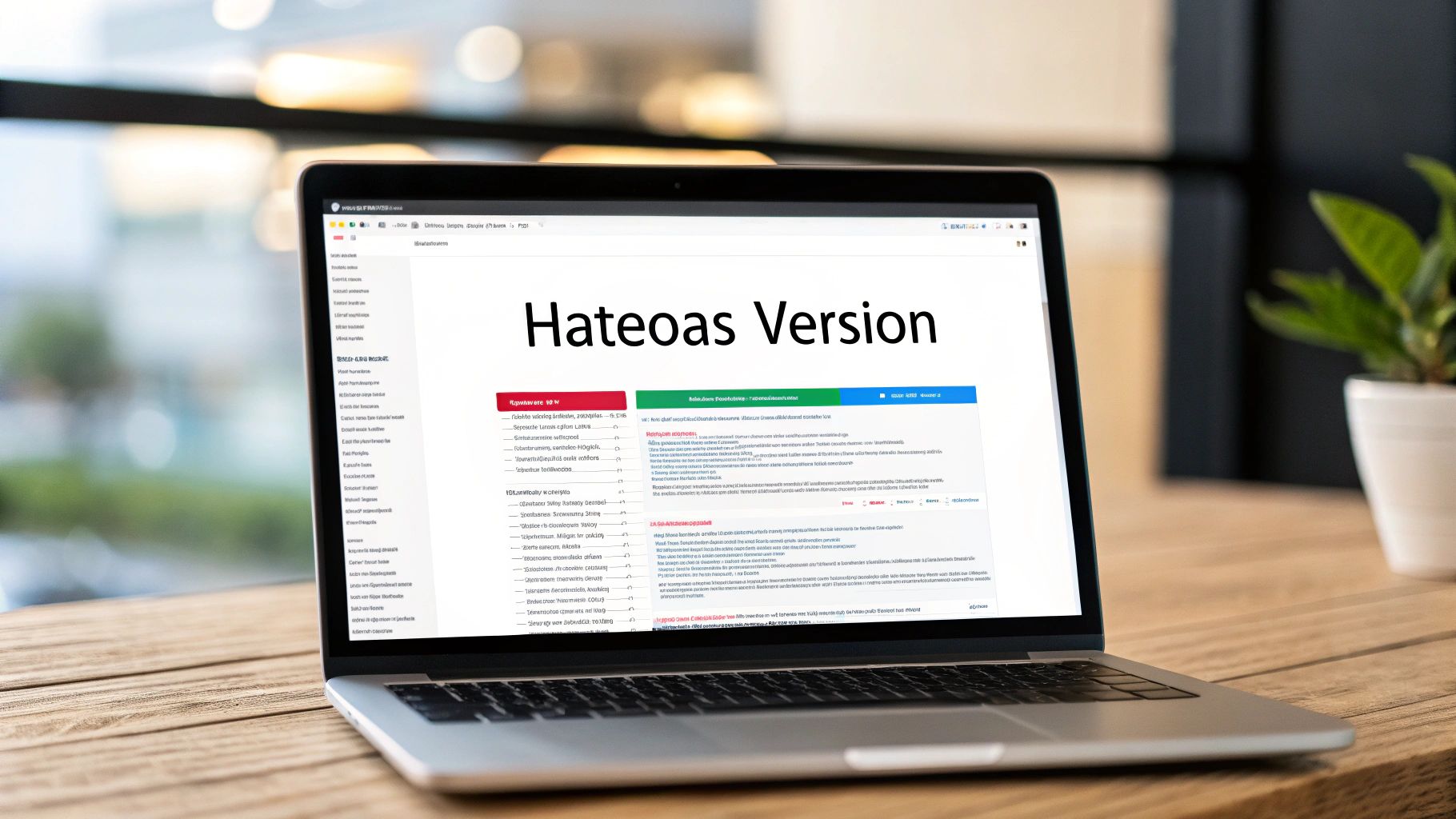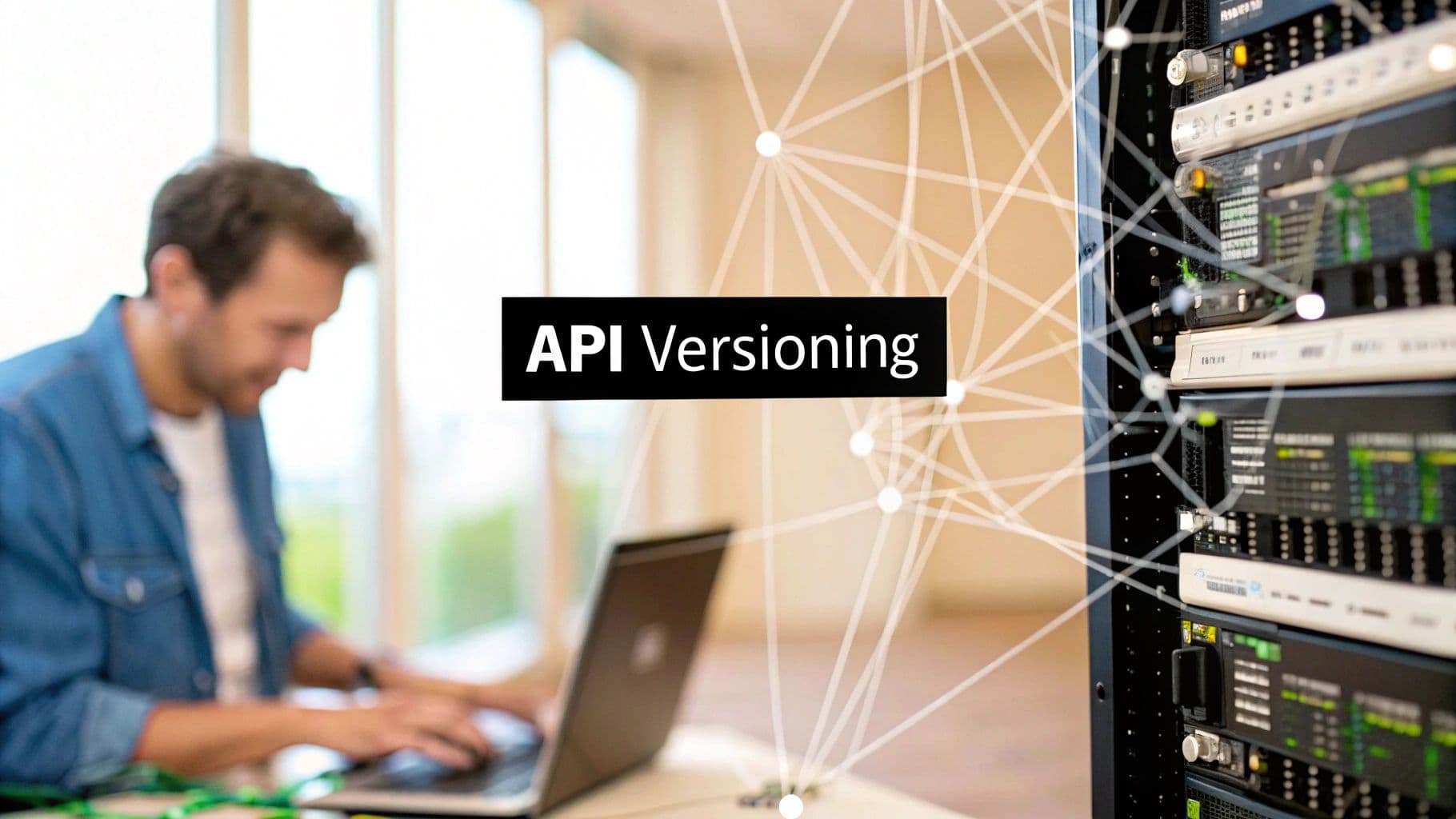api versioning
api versioning best practices
rest api
api design
api lifecycle
Top API Versioning Best Practices for Scalable APIs
Navigating the API Evolution: Why Versioning Matters
APIs constantly evolve, and proper versioning is crucial for preventing disruptions to integrated applications. This listicle presents six API versioning best practices to help you maintain backward compatibility and avoid breaking changes. Learn about URI path, HTTP header, content negotiation, query parameter, and semantic versioning techniques, plus hypermedia as the engine of application state (HATEOAS). Mastering these API versioning best practices will empower you to build robust and scalable APIs.
1. URI Path Versioning
URI path versioning is a popular and effective strategy for managing changes in web APIs. It involves embedding the API version number directly within the URI path, typically at the beginning. This method clearly indicates which version of the API is being accessed, making it easy for both developers and client applications to understand and manage different versions simultaneously. For example, a request to /v1/products explicitly targets version 1 of the product API. This direct inclusion of the version number in the URL is what distinguishes URI path versioning from other approaches.

This approach deserves its place in the best practices list due to its simplicity, clarity, and broad adoption across the industry. It's highly visible and self-documenting, requiring minimal effort for clients to understand which API version they are interacting with. Features like straightforward backend routing and compatibility with caching mechanisms further enhance its appeal. Popular APIs like GitHub, Stripe, and Twitter employ URI path versioning, demonstrating its effectiveness in real-world scenarios. For example, GitHub's API uses /v3/users to access version 3 of its user resource, while Stripe uses /v1/charges for its charge resource. Similarly, Learn more about URI Path Versioning can give you a deeper understanding of implementation details.
Pros:
- Highly visible and self-documenting: The version is readily apparent in the URL, simplifying understanding and debugging.
- Easy for clients to understand and use: Minimal client-side logic is required to switch between versions.
- Facilitates straightforward routing in backend systems: Mapping requests to the appropriate API version becomes relatively simple.
- Compatible with caching mechanisms: Caching can be implemented efficiently based on the versioned URI.
- Works well with API gateways and proxies: These tools can easily route requests based on the version in the URI.
Cons:
- Violates some REST purists' interpretation of resource identification: Some argue that the URI should identify the resource, not the representation.
- Can lead to URI proliferation as versions increase: Over time, numerous versions in the URI space can become unwieldy.
- Requires clients to modify their request URIs when upgrading versions: Clients must actively update their code to use newer versions.
- May require more complex server-side routing if supporting many versions concurrently.
Tips for Implementing URI Path Versioning:
- Keep version indicators simple: Use
v1,v2, etc., instead of complex date formats or semantic versioning. - Consider a default version: Handle requests without a specified version by defaulting to the latest or most stable version.
- Document version differences thoroughly: Clearly outline changes between versions in your API documentation.
- Handle deprecated versions gracefully: Use HTTP status codes like 301 (Moved Permanently) or 302 (Found) to redirect clients to the current version.
- Reserve major version increments for significant changes: Don't increment the major version number for minor updates or bug fixes.
URI Path Versioning is a strong choice for API versioning due to its ease of implementation, understandability, and widespread adoption. While it does have some drawbacks, its benefits often outweigh them, particularly for developers prioritizing clarity and simplicity. Whether you're a hobbyist, startup founder, freelance consultant, or technical lead, this method provides a robust and practical approach to managing your API's evolution. If you're prioritizing clarity and ease of implementation for both your team and your API consumers, URI path versioning is an excellent choice for your API versioning strategy.
2. HTTP Header Versioning
HTTP header versioning is a robust method for managing API versions that keeps your resource URIs clean and consistent. Instead of embedding the version number directly in the URI, this approach leverages custom HTTP headers to signal the desired API version. Clients specify the version they want to use through headers like Accept-version or X-API-Version, leaving the base URI focused solely on the resource itself. This adherence to RESTful principles makes your API more predictable and maintainable in the long run.

This method aligns with the core principles of REST, where URIs identify resources, not their representations. By decoupling versioning from the URI, you create version-agnostic endpoints that remain stable even as your API evolves. This stability simplifies client integration and reduces the risk of breaking changes when introducing new versions. For example, instead of having https://api.example.com/v1/users, you would have https://api.example.com/users and the client would specify the version using a header like Accept-version: v1. This approach allows for more flexibility in implementing fine-grained versioning strategies, leveraging HTTP content negotiation patterns.
HTTP Header versioning has seen successful implementations across various prominent APIs. While Microsoft Azure APIs primarily use query parameters for versioning, understanding header-based approaches provides a broader perspective on api versioning best practices and their applications in different contexts. GitHub, for instance, leverages the Accept header with custom media types (e.g., Accept: application/vnd.github.v3+json) to specify the desired API version. Atlassian demonstrates a hybrid approach, using both URI and header-based versioning in their APIs, providing flexibility for different use cases. Learn more about HTTP Header Versioning. This makes it especially relevant for developers working on complex systems that require integrating with various APIs and their potentially diverse versioning strategies.
While powerful, HTTP header versioning also comes with its own set of considerations. It's generally less visible than URI versioning, potentially making debugging slightly more complex. Additionally, there's a risk that proxies or firewalls might strip custom headers, leading to unexpected behavior. Testing can also be more involved, requiring tools that can manipulate HTTP headers. Server-side logic needs to be implemented to correctly interpret these versioning headers, adding to the development effort. Finally, ensuring client compatibility is essential, as not all clients readily support custom headers.
Tips for Effective HTTP Header Versioning:
- Clear Documentation: Since header versioning is less intuitive than URI versioning, thorough documentation is crucial. Clearly explain the chosen header names and accepted values.
- Flexibility through Multiple Approaches: Consider supporting multiple versioning mechanisms (e.g., both URI and header-based) to cater to diverse client needs.
- Consistent Naming: Use consistent header naming conventions across all your APIs to improve developer experience.
- Robust Error Handling: Implement clear and informative error messages for missing or incorrect version headers.
- Thorough Testing: Test with various proxy and caching configurations to ensure headers are preserved and interpreted correctly.
HTTP header versioning earns its place among API versioning best practices due to its adherence to RESTful principles, clean URIs, and flexibility. By carefully weighing the pros and cons and implementing the provided tips, developers can leverage this approach to create robust, scalable, and easily maintainable APIs. This is especially valuable for startup founders, freelance agencies, and product managers who need to ensure their APIs remain adaptable and developer-friendly throughout their lifecycle.
3. Content Negotiation Versioning
Content Negotiation Versioning stands as a robust yet nuanced approach to API versioning, fully embracing the core principles of HTTP and REST. It leverages the HTTP Accept header, allowing clients to specify the desired version of a resource by embedding version information within the media type. This adheres to the established HTTP content negotiation mechanism, where clients declare their preferred representation format (e.g., JSON, XML) and, in this case, also the desired version. This method distinguishes itself from other API versioning strategies by maintaining clean, version-agnostic URIs, placing the versioning logic within the request headers. This makes it a strong contender among API versioning best practices, especially for those prioritizing strict adherence to RESTful principles.
Instead of incorporating version numbers directly into the URL (e.g., /v1/users), Content Negotiation Versioning uses custom media types to convey version information. For instance, a client might request version 1 of a resource using an Accept header like application/vnd.company.resource.v1+json. This informs the server that the client expects a JSON representation of the resource conforming to version 1 of the company's specific media type.
Here's how it works in practice:
- Client Request: The client sends an HTTP request with an
Acceptheader specifying the desired versioned media type. - Server Interpretation: The server examines the
Acceptheader to determine the requested version. - Resource Retrieval and Formatting: The server retrieves the appropriate resource and formats it according to the requested version's schema.
- Response: The server responds with the resource representation in the specified format and version. If the server cannot fulfill the request, it should return an HTTP 406 (Not Acceptable) response.
Examples of Successful Implementation:
Several prominent APIs employ Content Negotiation Versioning, showcasing its practicality in real-world scenarios:
- GitHub API:
Accept: application/vnd.github.v3+json - PayPal API:
Accept: application/vnd.paypal.api+json;version=1.0 - Atlassian APIs:
application/vnd.atlassian.v1+json
These examples highlight how organizations leverage vendor-specific MIME types within the Accept header to communicate version preferences.
Pros and Cons:
While adhering to RESTful principles, Content Negotiation Versioning presents a trade-off between architectural purity and practical implementation:
Pros:
- Standards Compliance: Closely aligns with HTTP standards and REST principles.
- Clean URIs: Keeps URIs consistent and version-agnostic, enhancing readability and maintainability.
- Granular Versioning: Allows for fine-grained version control down to specific resource representations.
- Client-Driven Versioning: Clients explicitly request the versions they need, allowing for graceful transitions during API updates.
- Separation of Concerns: Decouples versioning from resource identification, simplifying API design.
Cons:
- Implementation Complexity: Requires more sophisticated content negotiation handling on the server side.
- Reduced Discoverability: Can be less intuitive for developers accustomed to versioning in the URL.
- Verbose Media Types: Custom media types can become lengthy and complex.
- Testing Challenges: More difficult to test using standard browser tools or simple HTTP clients.
Actionable Tips for Implementation:
- Structured Media Types: Define a clear and consistent structure for your vendor-specific media types.
- Default Version: Provide a default version as a fallback when the
Acceptheader doesn't specify a version. - Thorough Documentation: Document the content negotiation process comprehensively to guide API consumers.
- Handle Unsupported Versions: Implement proper HTTP 406 (Not Acceptable) responses when requested versions are unavailable.
- Consider Hybrid Approach: For developer convenience, consider supporting both Content Negotiation Versioning and a simpler versioning scheme like URI versioning.
When to Use This Approach:
Content Negotiation Versioning is ideal when strict adherence to RESTful principles and clean URIs are paramount. It's well-suited for projects where:
- API design emphasizes RESTful constraints.
- Long-term maintainability and evolvability are crucial.
- Granular control over versioning is required.
- The development team is comfortable with the complexities of content negotiation.
While it presents a steeper learning curve, Content Negotiation Versioning provides a robust and scalable solution for managing API versions, establishing a solid foundation for future growth and evolution. This makes it a valuable technique among api versioning best practices, particularly for projects aiming for long-term stability and REST compliance.
4. Query Parameter Versioning
Query parameter versioning is a straightforward method for managing API versions by including the version number directly within the request URL as a query parameter. This approach maintains a clean base URI for your resources while allowing for clear version differentiation. It's a popular choice among prominent APIs like Microsoft Azure, Google Maps, and LinkedIn, demonstrating its practicality for diverse use cases. This technique deserves a place in the list of API versioning best practices due to its simplicity, ease of implementation, and compatibility with existing web infrastructure.
How it Works:
The version of the API being requested is appended to the resource URL as a key-value pair. For example:
/users?version=1.0/products?api-version=2023-10-26/locations?v=3.47
Features and Benefits:
- Consistent Base URI: The core resource path remains unchanged across different API versions, promoting a stable and predictable API structure.
- Flexible Version Identifiers: You can use numeric, date-based, or semantic versioning schemes to identify your API versions. This allows you to choose a scheme that best suits your project's needs.
- Optional Parameter with Defaults: You can make the version parameter optional and set a default value (usually the latest version). This provides backward compatibility for clients that don't specify a version explicitly.
- Caching Compatibility: Query parameter versioning plays well with standard HTTP caching mechanisms. By including the version in the cache key, you can easily manage cached responses for different API versions.
Pros:
- Simple Implementation: Easy to implement and understand, requiring minimal code changes.
- Clean Resource Paths: Maintains clean and consistent resource URIs.
- Easy Defaulting: Allows for effortless defaulting to the latest version when the parameter is omitted.
- Caching Friendly: Works well with existing caching infrastructure.
- No Header Manipulation: Doesn't necessitate complex header manipulations.
Cons:
- Proxy Issues: Query parameters can sometimes be inadvertently dropped by intermediate proxies, leading to unexpected behavior.
- Caching Nuances: Requires careful configuration of caching mechanisms to ensure that the version parameter is included in cache keys.
- RESTful Purity: Some argue that query parameter versioning isn't strictly RESTful, as the version arguably represents a resource variant rather than a resource attribute.
- Parameter Confusion: Can create confusion if your API uses other functional query parameters.
- Documentation and Testing: The version parameter can be easily overlooked in documentation and testing processes.
Examples:
- Microsoft Azure APIs:
?api-version=2023-10-26 - Google Maps API:
?v=3.47 - LinkedIn API:
?version=202102
Tips for Effective Use:
- Consistent Parameter Name: Use a consistent parameter name (e.g.,
versionorapi-version) across all your APIs. - Parameter Interactions: Carefully consider how the version parameter interacts with other functional query parameters. Ensure there are no conflicts or ambiguities.
- Clear Versioning Scheme: Define a clear and consistent versioning scheme (numeric, date-based, or semantic).
- Optional with Default: Make the version parameter optional and provide a sensible default value (e.g., the latest version).
- Caching Configuration: Ensure your caching configurations account for the version parameter in cache keys.
When to Use Query Parameter Versioning:
This method is well-suited for scenarios where:
- You need a simple and quick way to implement versioning.
- Maintaining a clean and consistent base URI is a priority.
- You want to leverage existing caching infrastructure effectively.
- Your API doesn't involve complex versioning requirements.
By following these best practices, you can effectively leverage query parameter versioning to manage your API versions and provide a seamless experience for your users.
5. Semantic Versioning for APIs
Among the best practices for API versioning, Semantic Versioning (SemVer) stands out as a powerful and widely adopted method. It provides a structured and informative approach to managing API changes, enabling clear communication with consumers about the nature and impact of updates. This structured approach offers significant benefits, especially as your API evolves and gains wider adoption.

The infographic above visualizes the hierarchical structure of semantic versioning, showing how changes are categorized into major, minor, and patch levels. This hierarchy reflects the impact of the changes on API consumers, with major changes representing potential breaking changes, minor changes adding functionality without breaking existing integrations, and patch changes providing bug fixes without altering the API's functionality. The clear delineation between these levels helps developers understand the risks associated with each new version.
SemVer uses a three-part version number: MAJOR.MINOR.PATCH. Each part has a specific meaning and is incremented based on the type of change:
- MAJOR: Increment when you make incompatible API changes. This signals to consumers that they may need to update their code to continue using the API.
- MINOR: Increment when you add functionality in a backward-compatible manner. Existing integrations should continue to work seamlessly, but new features are available.
- PATCH: Increment when you make backward-compatible bug fixes. These changes should not affect existing integrations in any significant way.
This system, compatible with various version delivery methods like URI or header inclusion, intrinsically communicates compatibility information directly within the version number itself. For instance, changing an API version from 1.0.0 to 2.0.0 immediately indicates a potentially breaking change, while a change from 1.0.0 to 1.1.0 signifies backward-compatible feature additions.
Features and Benefits:
- Three-part numbering scheme: MAJOR.MINOR.PATCH provides granularity in versioning.
- Clear rules: Well-defined rules dictate when to increment each number.
- Compatibility with various delivery methods: Works with URI, header, and other methods.
- Built-in compatibility information: The version number itself signals the nature of the change.
- Structured evolution: Offers a structured approach to managing API versions.
Pros:
- Clearly communicates the impact of changes.
- Sets clear expectations regarding backward compatibility.
- Widely understood convention in software development.
- Helps clients make informed decisions about upgrading.
Cons:
- Often only the MAJOR version is used in URI paths, leading to some loss of detail.
- Can be challenging for teams to apply consistently.
- Can feel too rigid for rapidly evolving APIs.
- May lead to version proliferation.
- Requires discipline in change categorization.
Examples of Successful Implementation:
- NPM packages: The majority of Node.js libraries utilize SemVer.
- Docker API: Leverages SemVer principles for version management.
- Twilio API: While using V1/V2 in paths, Twilio employs SemVer principles for change management.
Tips for Implementation:
- Clear Guidelines: Document clear guidelines defining breaking versus non-breaking changes.
- URI Simplicity: Consider exposing only the MAJOR version in URIs while using the full SemVer internally.
- Detailed Changelog: Maintain a detailed changelog referencing semantic version changes.
- Deprecation Notices: Use deprecation notices for features to be changed in future major versions.
- API Testing: Implement API tests to verify backward compatibility for minor version changes.
Semantic versioning is crucial for API versioning best practices because it provides a standardized and transparent way to manage changes, communicate with consumers, and foster trust. By adhering to SemVer principles, developers can create more stable and predictable APIs, making them easier to integrate and maintain. Learn more about Semantic Versioning for APIs and explore how it can enhance your API development workflow. This is particularly important for independent developers, startup founders, freelance agencies, product managers, technical leads, and AI enthusiasts working with evolving APIs. Adopting robust versioning practices like SemVer ensures consistent functionality and minimizes disruption as your projects grow.
6. Hypermedia-Based Versioning (HATEOAS)
Hypermedia-as-the-Engine-of-Application-State (HATEOAS) represents a sophisticated approach to API versioning that aligns closely with the principles of RESTful architecture. Instead of relying on explicit version numbers in the URL, HATEOAS leverages hypermedia links embedded within API responses to guide clients to the correct version of a resource. This allows the API to evolve and change without breaking existing client integrations, as clients simply follow the provided links, effectively decoupling them from specific API versions. This approach facilitates a more flexible and evolvable API landscape, making it a crucial consideration when designing robust and long-lasting APIs and placing it firmly among API versioning best practices.

HATEOAS allows clients to discover API endpoints dynamically at runtime by following links included in the responses. Each response contains not just data, but also related links with semantic relations (e.g., "next", "previous", "related-product"). These links might point to different versions of resources without the client needing to know the specific version number. For instance, a response might include a link to /users/{id}/profile for the current version and another link relation like version-2 pointing to /v2/users/{id}/profile, allowing clients supporting newer versions to transition smoothly. This self-describing nature of HATEOAS responses promotes loose coupling between client and server, enabling independent evolution.
Examples of Successful Implementations:
- PayPal API: Utilizes HATEOAS principles with the HAL (Hypertext Application Language) format.
- Amazon AppStream 2.0 API: Incorporates HATEOAS principles for resource navigation and discovery.
- Spring Data REST: Automates the addition of hypermedia controls to Spring-based REST APIs.
Actionable Tips for Implementing HATEOAS:
- Use Established Formats: Implement HATEOAS using established hypermedia formats like HAL, JSON-LD, or Siren, which provide standardized ways to represent links and relationships in responses.
- Version in Relation Types (If Needed): Include version information in relation types if necessary, like
version-2, for backward compatibility while transitioning to newer representations. - Fallback Mechanisms: Provide fallback mechanisms for clients that don't fully support hypermedia, possibly allowing them to access versioned endpoints directly.
- Evolutionary Approach: Start with a simpler versioning approach and gradually evolve toward full hypermedia maturity as your API and client ecosystem mature.
- Deprecation Indicators: Use link relations to indicate deprecated or newer versions of resources, enabling clients to proactively adapt to API changes.
Pros and Cons of HATEOAS:
Pros:
- RESTful Alignment: Highly aligned with REST architectural principles.
- Evolutionary Flexibility: Allows the API to evolve without breaking clients that follow links.
- Reduced Explicit Versioning: Reduces the need for explicit versioning in many scenarios.
- Graceful Transitions: Can handle complex version transitions more gracefully.
- Loose Coupling: Promotes loose coupling between client and server.
Cons:
- Implementation Complexity: More complex to implement correctly than simpler methods.
- Learning Curve: Higher learning curve for API consumers.
- Reduced Intuitiveness: Less intuitive than explicit versioning approaches for some developers.
- Client Sophistication: Requires more sophisticated client implementations to follow links.
- Documentation Challenges: Can be more challenging to document comprehensively.
When to Use HATEOAS:
Consider using HATEOAS when building APIs designed for long-term evolution, complex resource relationships, and diverse client ecosystems. While it introduces complexity, the benefits of decoupling and evolvability can be substantial in the long run, justifying the initial investment. This method is particularly well-suited for scenarios where clients are expected to discover and interact with resources dynamically, allowing the server to guide their navigation through different versions and representations.
API Versioning Methods Comparison
| Versioning Method | 🔄 Implementation Complexity | 🛠️ Resource Requirements | 📊 Expected Outcomes | 🎯 Ideal Use Cases | ⭐ Key Advantages |
|---|---|---|---|---|---|
| URI Path Versioning | Low 🔄 | Low to Medium | Clear version visibility, easy routing | Public APIs needing explicit versioning and caching | Highly visible, easy to use, cache-friendly |
| HTTP Header Versioning | Medium 🔄 | Medium | Stable URIs, clean resource identification | APIs aiming for REST purity and flexible versioning | Clean URIs, flexible, adheres to REST |
| Content Negotiation Versioning | High 🔄 | Medium to High | Granular versioning, content-specific responses | Complex APIs requiring fine-grained version control | Fully HTTP compliant, flexible version requests |
| Query Parameter Versioning | Low 🔄 | Low | Consistent base URI, optional versions | Simple APIs wanting version flexibility without URI changes | Simple, flexible, easy defaults |
| Semantic Versioning for APIs | Medium 🔄 | Low to Medium | Informative versioning indicating compatibility | APIs requiring clear semantic change communication | Communicates change impact, widely understood |
| Hypermedia-Based Versioning (HATEOAS) | High 🔄 | High | Dynamic endpoint discovery, loose coupling | Advanced RESTful APIs needing evolution without breakage | Highly RESTful, dynamic, reduces client coupling |
Building Future-Proof APIs: Embracing Best Practices
Effective API versioning is more than just a technical detail; it's a strategic imperative. Throughout this article, we've explored several API versioning best practices, from the simplicity of URI path versioning and query parameters to the more nuanced approaches of HTTP header versioning and content negotiation. We've also delved into the importance of semantic versioning and the power of HATEOAS for building truly evolvable APIs. Mastering these concepts is crucial for anyone building APIs intended for long-term use and a broad audience. By carefully considering these approaches and choosing the strategy that best aligns with your API's goals, you can create a robust and adaptable platform that can gracefully handle changes and updates without disrupting your users. This foresight allows you to foster a thriving developer ecosystem around your API and ensures its continued success. Implementing these API versioning best practices empowers you to confidently navigate the ever-changing technology landscape, ensuring your APIs remain relevant and valuable for years to come.
Looking for a streamlined way to implement these API versioning best practices and reduce development overhead? AnotherWrapper provides integrated tools and pre-built components designed to simplify API versioning, allowing you to focus on building amazing features. Visit AnotherWrapper and discover how it can help you build future-proof APIs today.
Fekri




